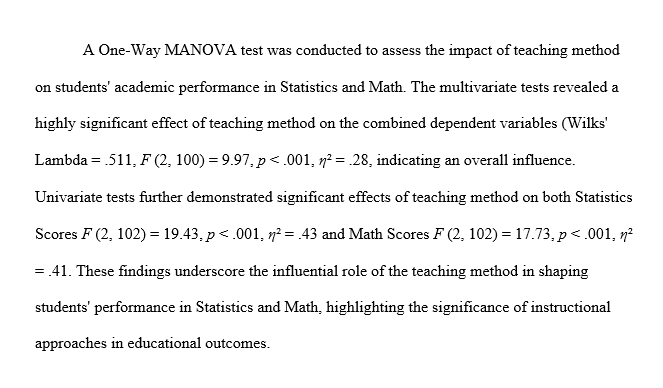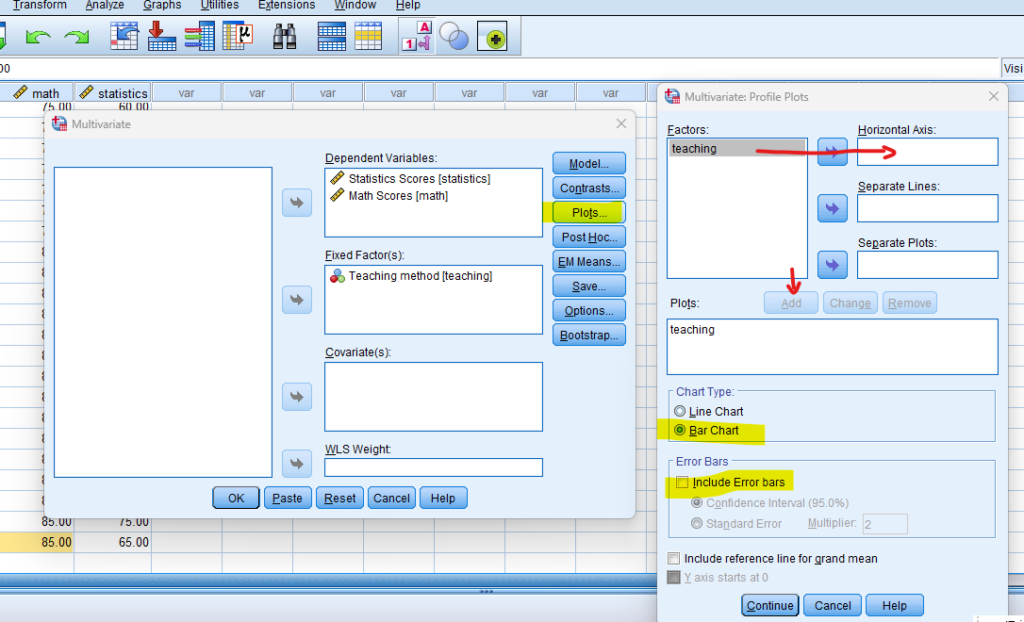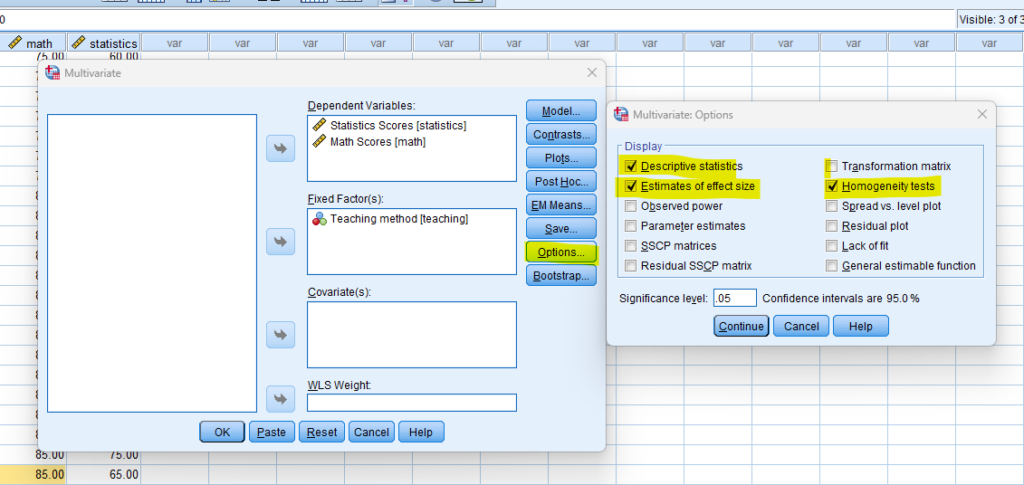Multivariate Analysis of Variance in SPSS
Discover Multivariate Analysis of Variance in SPSS! Learn how to perform, understand SPSS output, and report results in APA style. Check out this simple, easy-to-follow guide below for a quick read!
Struggling with the One-Way MANOVA Test in SPSS? We’re here to help. We offer comprehensive assistance to students, covering assignments, dissertations, research, and more. Request Quote Now!
Introduction
Embarking on the realm of statistical analysis, our exploration today centers on the One-Way Multivariate Analysis of Variance (MANOVA) in SPSS. This robust statistical technique extends the capabilities of its univariate counterpart, allowing researchers to simultaneously assess the impact of a single independent variable on multiple dependent variables. Whether you are a seasoned statistician or delving into these analyses for the first time, this blog post aims to demystify One-Way MANOVA, guiding you through its definition, assumptions, practical application, and interpretation using the powerful tool, SPSS.
Definition
Multivariate Analysis of Variance (MANOVA) is a technique designed to investigate the impact of a single independent variable on two or more dependent variables simultaneously. This method expands beyond the limitations of univariate analysis, offering a comprehensive examination of relationships between variables. As we delve into the subsequent sections, we’ll explore the assumptions integral to One-Way MANOVA, formulate hypotheses for insightful testing, and guide you through the step-by-step process of executing and interpreting this analysis using SPSS.
Assumption of One-Way MANOVA Test
Before immersing ourselves in the practical application of One-Way MANOVA, it’s essential to establish the key assumptions underpinning the reliability of this analytical method:
- Multivariate Normality: The dependent variables should collectively exhibit a multivariate normal distribution. This assumption ensures the accuracy of statistical inferences derived from MANOVA.
- Homogeneity of Covariance Matrices: The covariance matrices of the dependent variables across different groups should be roughly equal. This assumption, known as homogeneity of variance-covariance, ensures the robustness of the MANOVA results.
- Linearity: The relationships between the independent variable and each dependent variable should be linear. Linearity is fundamental for the accurate interpretation of MANOVA outcomes.
Adherence to these assumptions is critical to the validity of One-Way MANOVA results, providing a solid foundation for robust statistical analysis.
The hypothesis of One-Way MANOVA Test
Moving on to the formulation of hypotheses in the context of One-Way MANOVA, we establish the following hypotheses, addressing the impact of the independent variable on the set of dependent variables:
First DV
- Null Hypothesis (H01): There is no significant difference in the mean vectors of the first dependent variables across the levels of the independent variable.
- Alternative Hypothesis (H11): There is a significant difference in the mean vectors of the first dependent variables across the levels of the independent variable.
Second DV
- Null Hypothesis (H02): There is no significant difference in the mean vectors of second dependent variables across the levels of the independent variable.
- Alternative Hypothesis (H12): There is a significant difference in the mean vectors of second dependent variables across the levels of the independent variable.
These hypotheses set the stage for statistical testing, allowing researchers to discern whether variations in the independent variable lead to significant differences in the multivariate pattern of the dependent variables. In the subsequent sections, we’ll illustrate these concepts with a practical example and guide you through the step-by-step process of performing and interpreting One-Way MANOVA in SPSS.
Example of Multivariate Analysis of Variance (MANOVA)
Consider a research scenario where investigators are examining the impact of different teaching methods on students’ academic performance across multiple subjects. The independent variable is the teaching method (e.g., traditional lectures, interactive workshops, online modules), and the dependent variables are the scores obtained by students in various subjects. Instead of conducting separate univariate analyses for each subject, One-Way MANOVA enables a holistic exploration of how the teaching method influences the multivariate pattern of academic performance across subjects.
Math Scores: DV1
- Null Hypothesis: There is no significant difference in the mean vectors of Math scores across the levels of the teaching method variable.
- Alternative Hypothesis: There is a significant difference in the mean vectors of Math scores across the levels of the teaching method variable.
Statistics Scores: DV2
- Null Hypothesis: There is no significant difference in the mean vectors of Statistics scores across the levels of the teaching method variable.
- Alternative Hypothesis: There is a significant difference in the mean vectors of Statistics scores across the levels of the teaching method variable.
These hypotheses allow researchers to specifically test whether different teaching methods have a significant impact on the multivariate patterns of scores in both Math and Statistics. The subsequent One-Way MANOVA analysis can then provide statistical evidence to support or refute these hypotheses.
Step by Step: Running One Way MANOVA Test in SPSS Statistics
Let’s delve into the step-by-step process of conducting the One-Way MANOVA Test using SPSS. Here’s a step-by-step guide on how to perform a Multivariate Analysis of Variance (MANOVA) in SPSS:
- STEP: Load Data into SPSS
Commence by launching SPSS and loading your dataset, which should encompass the variables of interest – a categorical independent variable. If your data is not already in SPSS format, you can import it by navigating to File > Open > Data and selecting your data file.
- STEP: Access the Analyze Menu
In the top menu, locate and click on “Analyze.” Within the “Analyze” menu, navigate to “General Linear Model” and choose ” Multivariate” Analyze > General Linear Model> Multivariate
- STEP: Specify Variables
In the dialogue box, move the dependent variables to the “Dependent Variable” field. Move the variable representing the group or factor to the “Fixed Factor (s)” field. This is the independent variable with different levels or groups.
- STEP: Post-Hoc and Plots
Click on the “Plot” button, Move to Factor into the Horizontal Axis, and then click the “Add” button.
Go on the “Post Hoc” button, Check “Tukey” or “Games-Howell”, and then click the “OK” button.
- STEP: Options
Snap-on the “Options” button Check “Descriptive”, “Homogeneity Test” and “Estimates of effect size”
- STEP: Generate SPSS Output
Once you have specified your variables and chosen options, click the “OK” button to perform the analysis. SPSS will generate a comprehensive output, including the requested frequency table and chart for your dataset.
Note
Conducting a One-Way ANOVA test in SPSS provides a robust foundation for understanding the key features of your data. Always ensure that you consult the documentation corresponding to your SPSS version, as steps might slightly differ based on the software version in use. This guide is tailored for SPSS version 25, and for any variations, it’s recommended to refer to the software’s documentation for accurate and updated instructions.
SPSS Output for Multivariate Analysis of Variance
How to Interpret SPSS Output of MANOVA Test
When interpreting the SPSS output of One-Way MANOVA, focus on key elements that provide insights into the impact of the independent variable on the set of dependent variables:
Descriptives Table
- Mean and Standard Deviation: Evaluate the means and standard deviations of each group. This provides an initial overview of the central tendency and variability within each group.
- Sample Size (N): Confirm the number of observations in each group. Discrepancies in sample sizes could impact the interpretation.
- 95% Confidence Interval (CI): Review the confidence interval for the mean difference.
Box’s M Test
- Box’s M test for homogeneity of covariance matrices: A significant result may indicate a violation of the assumption of homogeneity of variances.
Multivariate Tests Table
Multivariate Tests table for additional statistical information, including Wilks’ Lambda Test, Pillai’s Trace, Hotelling’s Trace, and Roy’s Largest Root. These tests contribute to the overall assessment of the impact of the independent variable.
- Wilks’ Lambda test: A significant result indicates that there are significant differences in the multivariate pattern of the dependent variables across the levels of the independent variable.
Test of Homogeneity of Variances Table
- Levene’s Test: In the Test of Homogeneity of Variances table, look at the Levene’s Test statistic and associated p-value. This test assesses whether the variances across groups are roughly equal. A non-significant p-value suggests that the assumption of homogeneity of variances is met.
Tests of Between-Subjects Effects
- Between-Groups: Move on to the ANOVA table, which displays the Between-Groups, degrees of freedom, mean squares, the F-ratio, and the p-value.
- F-Ratio: Focus on the F-ratio. A higher F-ratio indicates larger differences among group means relative to within-group variability.
- Degrees of Freedom: Note the degrees of freedom for Between-Groups. These values are essential for calculating the critical F-value.
- P-Value: Examine the p-value associated with the F-ratio. If the p-value is below your chosen significance level (commonly 0.05), it suggests that at least one group’s mean is significantly different.
- Eta-squared: If available, consider effect size measures in the ANOVA table. Eta-squared indicates the proportion of variance in the dependent variable explained by the group differences.
Post Hoc Tests Table (If Applied):
- Specific Group Differences: If you conducted post-hoc tests, examine the results. Look for significant differences between specific pairs of groups. Pay attention to p-values and confidence intervals to identify which groups are significantly different from each other.
By systematically analysing these components, you gain a comprehensive understanding of whether there are significant differences in the multivariate pattern of dependent variables across the levels of the independent variable. In the following section, we’ll guide you on how to report the results of One-Way MANOVA in APA style, ensuring clarity and adherence to academic standards.
How to Report Results of One-Way MANOVA Test in APA
Crafting a concise and structured report of your One-Way MANOVA results in APA style ensures effective communication. Here’s a step-by-step guide:
- Introduction: Begin with a brief introduction, outlining the purpose of the analysis and specifying the independent variable and dependent variables under investigation.
- Analysis Conducted: Clearly state that a One-Way MANOVA was conducted to examine the impact of [Independent Variable] on the multivariate pattern of [Dependent Variables].
- Results Summary: Present a summary of the results, including the significance level of the Wilks’ Lambda test. For example, “The analysis revealed a significant effect of [Independent Variable] on the multivariate pattern of [Dependent Variables] (Wilks’ Lambda = [value], F(df1, df2) = [F-ratio], p = [p-value]).”
- Post-Hoc Tests (If Applied): If post-hoc tests were conducted, report significant differences between specific groups. For instance, “Post-hoc tests using [Post-Hoc Test] indicated a significant difference between [specific groups] (p < 0.05).”
- Effect Size Measures (Optional): If relevant, report effect size measures (e.g., partial eta-squared) to provide insights into the practical significance of the findings.
Conclude by discussing the implications of your results and their broader relevance. Address any limitations of the study and suggest avenues for future research. This structured approach ensures that your report is informative and aligns with the conventions of APA style, providing a clear and concise summary of your One-Way MANOVA analysis.

Get Help For Your SPSS Analysis
Embark on a seamless research journey with SPSSAnalysis.com, where our dedicated team provides expert data analysis assistance for students, academicians, and individuals. We ensure your research is elevated with precision. Explore our pages;
- SPSS Data Analysis Help – SPSS Helper,
- Quantitative Analysis Help,
- Qualitative Analysis Help,
- SPSS Dissertation Analysis Help,
- Dissertation Statistics Help,
- Statistical Analysis Help,
- Medical Data Analysis Help.
Connect with us at SPSSAnalysis.com to empower your research endeavors and achieve impactful results. Get a Free Quote Today!














